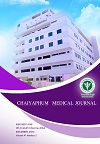Rational Drug Use Evaluation of Antibiotic in Fresh trauma wound in Chaiwan Hospital, Udonthani.
Keywords:
Rational Drug Use, Fresh traumatic woundAbstract
Background: The Ministry of Public Health requires “Use of antibiotics in fresh traumatic wounds” is one of the Key Performance Indicator (KPI) of the Service plan in the field of Rational Drug Use (RDU) with the goal is the rate of antibiotic use is not more than 40 percent. Chaiwan Hospital has adopted the policy according to the RDU service plan to reduce the excessive antibiotic.
Objective: (1) To evaluate antibiotic use in patients with fresh traumatic wounds. (2) To determine the prevalence of antibiotic use in patients with fresh traumatic wounds. (3) To determine the factors related to the prescribing of antibiotics in patients with fresh tramatic wounds.
Methods: This study was a retrospective descriptive research. The population and sampling were patients with fresh wounds from accidents during February 1 - April 30, 2021 were 598 and 229, respectively.
Results: The total 229 patients, most of them were male, 58.95%, average age of 35.76 ± 23.13 years and without co-morbidity (84.72%). The most common wound sites were on the leg 24.0%, The most of them were group 3, wounds contaminated and should be given antibiotics. The most common were 38.43% of animal bite wounds. Prevalence of antibiotic prescribing were 48.63%, The most common antibiotic used were Dicloxacillin (53.15%), followed by Amoxicillin (41.44%). Average duration of antibiotic used was 4.66 ± 1.86 days. According to the guideline, the rate of appropriate antibiotic used was 71.62%. Factors were significantly related antibiotic used were co-morbidity, type of wound and type of wound according to the guideline (p<0.05). Infectious wound did not occurred in study.
Conclusion: The prevalence of antibiotic use in fresh traumatic wounds in Chaiwan Hospital was higher than the target. The rate of appropriate antibiotic use was 71.62% but 64.86% were inappropriate for the duration of antibiotics and 5.41% were inappropriate in choosing the drug type. Factors were significantly related antibiotic used were co-morbidity, type of wound and type of wound according to the guideline. Therefore, Chaiwan Hospital had to develop a service system. The use of antibiotics in fresh wounds for further suitability
References
นิธิมา สุ่มประดิษฐ์. ภูมิทัศน์ของสถานการณ์และการจัดการการดื้อยาต้านจุลชีพในประเทศไทย. กรุงเทพฯ : อักษรกราฟฟิคแอนด์ดีไซน์, 2558;p:17-34.
Thamlikitkul V, RattanaumpawanvP, BoonyasirivA, Sirijatuphat R, Jaroenpoj S. Operational Actions of the Thailand Antimicrobial Resistance (AMR) Containment and Prevention Program in Response to the World Health Organization (WHO) Global Action Plan on AMR. Journal of Health Systems Research, 2017;11(4):453-70.
ชุติมาภรณ์ ไชยสงค์, พิริยา ติยาภักดิ์, สมพิศ ปินะเก, สรุศักดิ์ ไชยสงค์. ความสัมพัน์ของปริมาณการใช้ยาและการดื้อยาปฏิชีวนะในโรงพยาบาลมหาสารคาม. วารสารเภสัชศาสตร์อีสาน, 2562;15(2):98-105.
Sirijatuphat R, Choochan T, Siritongtaworn P, Sripojtham V, Thamlikitkul V. Implementation of Antibiotic Use Guidelines for Fresh Traumatic Wound at Siriraj Hospital. J Med Assoc Thai, 2015;98(3):245-52.
Sirijatuphat R, Siritongtaworn P, Sripojtham V, Boonyasiri A, Thamlikitkul V. Bacterial contamination of fresh traumatic wounds at Trauma Center, Siriraj Hospital, Bangkok Thailand. J Med Assoc Thai, 2014;97(Suppl 3):S20-5.
Quinn JV, Polevoi SK, Kohn MA. Traumatic lacerations: what are the risks for infection and has the ‘golden period’ of laceration care disappeared?. Emerg Med J, 2014;31(2):96-100.
Cummings P, Del Beccaro MA. Antibiotics to prevent infection of simple wounds: a meta-analysis of randomized studies. Am J Emerg Med, 1995;13(4):396-400.
พรพิมล จันทร์คุณาภาส, รำไพ บุญญะฤทธิ์, วรนัดดา ศรีสุพรรณ, ไพทิพย์ เหลืองเรืองรอง และนุชน้อย ประภาโศ. การพัฒนาระบบบริการสุขภาพ สาขาพัฒนาระบบบริการให้มีการใช้ยาอย่างสมเหตุผล. นนทบุรี : กลุ่มงานพัฒนาระบบสนับสนุนบริการ สำนักบริหารการสาธารณสุข สำนักงานปลัดกระทรวง สาธารณสุข, 2559.
พิสนธิ์ จงตระกูล. การใช้ยาอย่างสมเหตุผลใน Primary care. พิมพ์ครั้งที่ 6. กรุงเทพฯ: คณะแพทย์ศาสตร์ จุฬาลงกรณ์มหาวิทยาลัย, 2560.
ชุติมาภรณ์ ไชยสงค์, พิริยา ติยาภักดิ์, อนันตเดช วงศรียา,สุรศักดิ์ ไชยสงค์. ประเภทของบาดแผลและรูปแบบการใช้ยาปฏิชีวนะในผู้ป่วยอุบัติเหตุของ โรงพยาบาลมหาสารคาม. วารสารวิจัยระบบสาธารณสุข, 2562;13(1):116-24.
ณัฐพล เอโกบล , ศิรินทิพย์ บุญจรัสภิญโญ. การนำแบบประเมินแผลสดเพื่อพิจารณาการใช้ยาปฏิชีวนะเพื่อป้องกันแผลติดเชื้อไปใช้ สำหรับผู้ป่วยนอก .[อินเตอร์เน็ต]. 2561 [เข้าถึงเมื่อ 3 กันยายน 2562]. เข้าถึงได้จาก: http://203.157.3.56/APP/SERVICEPLAN/uploads/service14/files/basic-html/page20.html
อธิรัฐ บุญญาศิริ. Antibiotics Smart Use ที่โรงพยาบาล ศิริราช. [อินเตอร์เน็ต]. 2555 [เข้าถึงเมื่อ 3 กันยายน 2562]. เข้าถึงได้จาก: http://www.wongkarnpat.com/viewpat.php?id=765
ศิริรัตน์ ไสไทย. สถานการณ์การใช้ยาปฏิชีวนะอย่างสมเหตุผลในโรคบาดแผลสดจากอุบัติเหตุในโรงพยาบาลของรัฐ จังหวัดกระบี่. กระบี่เวชสาร, 2562;2(2):29-35.
พรชนิตว์ หมื่นหน้า, ชาญกิจ พุฒิเลอพงศ์. การให้ยาปฏิชีวนะเพื่อป้องกันการติดเชื้อในแผลจากสุนัขและแมวกัด/ข่วน. วารสารเภสัชกรรมไทย, 2562;11(3):540-51.
Downloads
Published
Versions
- 2022-01-05 (2)
- 2021-12-29 (1)
Issue
Section
License
Copyright (c) 2021 Chaiyaphum Medical Journal : ชัยภูมิเวชสาร

This work is licensed under a Creative Commons Attribution-NonCommercial-NoDerivatives 4.0 International License.





